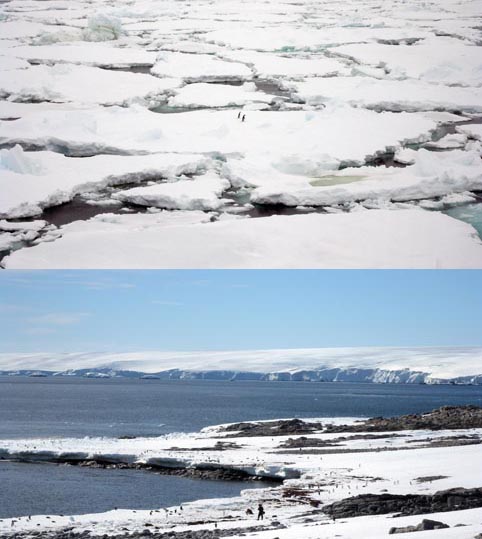Antarctic ice is the biggest unknown in our quest to get a handle on future sea levels, but it looks as if it will play a key role. [5 May 2009 | Peter Boyer]
We all know that ice is frozen water, found wherever it’s cold enough – in the fridge, on mountain-tops, at the poles – and we know that when ice gets warm, it melts. So if it warms up at the poles, the ice there will melt. Pretty straightforward, really.

TOP – SEA ICE: Sea ice cover in the Southern Ocean is calculated to have increased slightly in recent years. BOTTOM – LAND ICE: Scientists are concerned that where West Antarctica’s land ice meets a warming ocean, it could melt from the edges toward the centre, destablising the whole ice sheet.
Well, not so simple, as it happens. How a rise in the average global temperature will cause ice to behave at continental scale – which is what we’re looking at in Antarctica – and how this will affect world sea levels are complex processes. As a result, a lot of people are confused.
In the Arctic we have an ocean over the North Pole with a cover of sea ice that’s getting smaller with warming ocean waters. That has no impact on sea levels because the ice is floating. But then there’s the large, rocky, ice-covered island of Greenland.
Rising air temperatures are causing Greenland’s land-based ice to decay, adding volume to the sea. We don’t know exactly how this will proceed, so we don’t yet know how quickly it will cause seas to rise. What we can say is that Greenland ice is now a big and increasing influence on sea levels.
If Greenland is big, Antarctica is bigger. Its ice sheet is ten times bigger than Greenland’s and its story is even more complex and more problematic. This came into sharp relief last month when a news story about Antarctica’s ice provoked some lively – and disconcerting – internet discussions.
The story was based on research indicating that Antarctic sea ice cover may be increasing. The Australian’s Greg Roberts reported this under the headline “Antarctic ice is growing, not melting away” – a headline that some readers (Senator Barnaby Joyce among them, judging by his comments on ABC-TV’s Q&A program last week) took as more evidence that global warming was baloney.
Public knowledge of the Antarctic has never been strong compared to, say, who won the weekend footy. Take this reader comment on The Australian website: “The southern ice cap is growing, a fact never disputed by scientific measurement.” Or this: “The Antarctic didn’t form on a body of land, it’s floating on the largest body of water on the planet.”
Both statements are wrong, but who’s to know? Relatively few people understand the difference between sea ice – formed when the ocean’s surface is cold enough to freeze – and land-based ice, which sits on rock and is formed from falling snow over thousands of years.
Global warming is not felt uniformly across the planet, and scientists have not been surprised to find sea ice cover increasing in parts of the Southern Ocean, mainly off East Antarctica, south of Australia. But the main concern about Antarctica is whether it’s losing or gaining land-based ice, because loss of this ice could dramatically alter the level of our oceans in coming decades.
The evidence about the state of the Antarctic ice sheet has been equivocal in the past, but there’s increasing agreement that a slight gain in East Antarctica is more than offset by losses in West Antarctica (south of South America). The continent as a whole is presently contributing about a quarter of a millimetre to sea level rise each year.
Right now, it’s ridiculous to say that Antarctica’s ice sheet floats on the ocean, yet that may not always be so. Under the ice, West Antarctica isn’t a continent but a series of islands. Most of its ice sits on rock that is below sea level – and that makes it inherently unstable.
Ocean warming around West Antarctica will cause the edge of the ice sheet to start melting from below, and glaciologists believe this peripheral thinning could extend toward the centre of Antarctica, destablising the whole edifice.
If that happens, sea levels would rise not millimetres but metres – possibly very quickly. As well as watching Greenland, a wise coastal planner will also keep a weather eye on West Antarctica.
